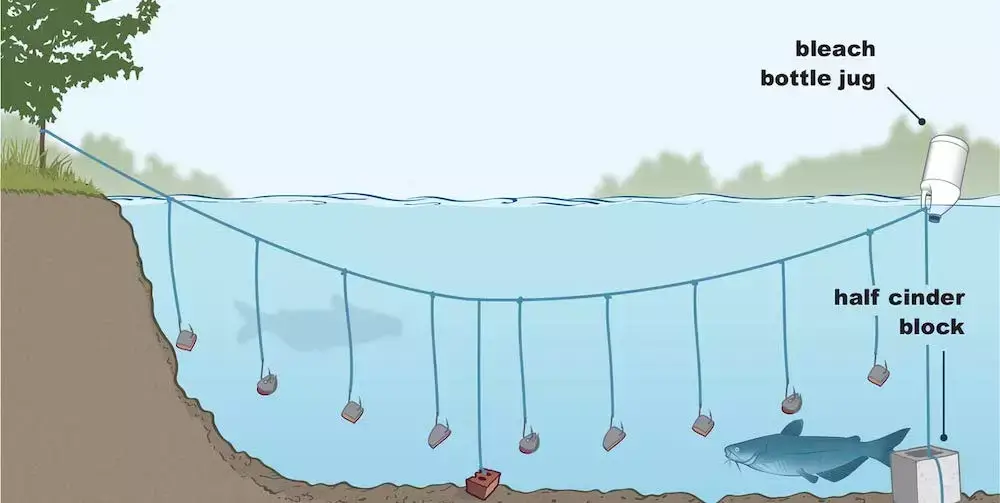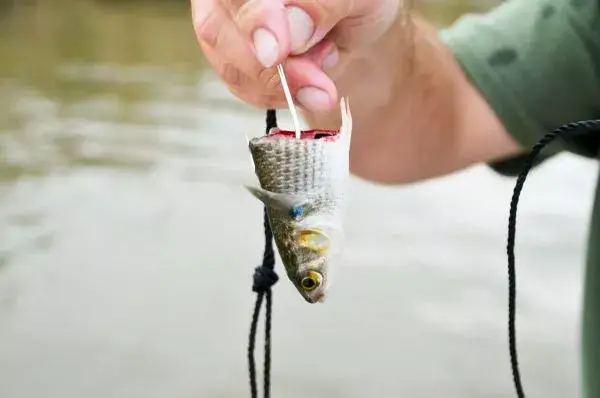One of the most important things to learn is how deep to set your jug lines when you’re just starting fishing. Jug lines are a great way to catch fish, but you won’t be catching anything if they’re not set at the correct depth.
In this article, we’ll teach you how to determine how deep to set your jug lines and start reeling in those big catches.
What Are Jug Lines, and How Do They Work?
Using a jug or other container, jug lines work by suspending a baited line in the water. The weight of the line pulls the bait down to where fish are likely to be feeding. Jug lines can be set at different depths, depending on what type of fish you are targeting.
Some fishermen prefer to use a weighted line, while others tie a rock to the end of the line. The main advantage of using a weighted line is that it helps keep the bait at the desired depth.
When setting your jug lines, it is important to use a weight to keep the line vertical in the water. This will help ensure that the bait hangs straight down and not at an angle.
Also, if you are using multiple jugs, make sure they are spaced far enough apart so that the lines do not get tangled together.
When baiting your jug lines, it is important to use a variety of bait. Some good choices include worms, minnows, frogs, and crayfish.
You can also use artificial lures, such as spinnerbaits or jigs. Be sure to use enough bait to attract fish, but not so much that it will get tangled in the line.
What Line of Work Do You Use for Jug Lines?

When it comes to how deep to set jug lines, there are a few different factors that you need to take into account. The first thing you’ll need to figure out is what type of line you’re using.
There are three main types of fishing lines: monofilament, braided, and fluorocarbon. Each one has its strengths and weaknesses, so you’ll need to decide which is best for your needs.
The monofilament line is the most common type of fishing line. It’s strong, durable, and affordable, making it an excellent option for beginners. However, it can be susceptible to wind and waves, so be careful when using it in windy or choppy conditions.
A braided line is a good option for those looking for a durable line that can handle heavy loads. It’s also less affected by wind and waves than the monofilament line, making it a better choice for fishing in harsh conditions. However, it is more expensive than the monofilament line and can be harder to work with.
The fluorocarbon line is the most expensive of the three options, but it’s also the most sensitive and has low memory. This means that it won’t kink or curl like the other two types of lines can. As a result, it’s a good choice for those looking for a line that will give them a lot of feedback when fishing.
How Deep to Set Jug Lines
Once you’ve decided on the type of line you’re going to be using, you need to determine how deep to set jug lines for your specific situation. There are a few different ways to do this, but we’ll discuss two of the most common methods: weight and depth finders.
The weight method is the most common way to determine how deep to set jug lines. To use this method, you’ll need to tie a weight onto your line that’s heavier than the water will be at the desired depth.
For example, if you’re fishing in a creek that has a maximum depth of six feet, you’ll need to tie a weight that’s at least six pounds onto your line. This will ensure that your jug lines are set at the desired depth.
The depth finder method is another way to determine how deep to set jug lines. You’ll need to attach a depth finder to your queue to use this method. This will allow you to track how deep your jug lines are set.
This is a good option for those fishing in deeper waters, as it will help you ensure that your jug lines are set at the correct depth.
How Heavy Is a Jug Line?

When fishing with jug lines, this is an important question because you don’t want your line to sink too deep and become lost. Most jugs weigh around two or three pounds but can vary depending on the size of the container and how much bait is used.
Another thing to consider when determining how deep to set your jug lines is the type of bait you’re using. Like minnows or worms, live bait will sink to the bottom while cut bait, like chicken livers or hot dogs, will float.
A good general rule of thumb is to set your jug lines anywhere from two to four feet deep, depending on how heavy your jugs are and how deep you want your bait to be. Then, experiment a little and see what works best for you.
Live bait vs Cut bait
When it comes to fishing with jugs, there are two main types of bait: live bait and cut bait. Live bait can include minnows and nightcrawlers, while cut bait is typically made up of fish parts or scraps.
Both have their advantages, but which one you use will largely depend on what type of fish you’re targeting.
Generally, live bait is better for shallow water fishing, while cut bait works better in deeper waters. That said, there are no hard and fast rules, so it’s always worth experimenting to see what produces the best results.
What Is the Purpose of a Jug Permit?
A jug permit is a fishing license that allows you to use up to five jug lines. Jug lines are fishing lines attached to jugs, floating containers used to attract fish. Jug lines can be used in both freshwater and saltwater fisheries.
Jug permits are available for residents and non-residents. The resident fee is $15, and the non-resident fee is $30.
Jug lines can be used to fish for various species, including catfish, bass, trout, salmon, and walleye. The depth at which you set your jug line will vary depending on the type of fish you are targeting.
In general, you will want to set your jug lines in deeper water for larger fish, such as catfish and bass. Conversely, you can set your jug lines in shallower water for smaller fish, like trout and salmon.
When fishing for catfish, you will typically want to set your jug lines in the 20-30 foot range. Likewise, you will want to set your jug lines in the 30-50 foot range for bass.
When fishing for trout, you will want to set your jug lines in the six-12 foot range. Likewise, you will want to set your jug lines in the four-eight-foot range for salmon.
You will want to set your jug line in the eight-12 foot range for walleye.
Is It Possible to Fish for Crappie with a Jug?
Yes, you can jug fish for crappie. Jug fishing is a great way to catch crappie because they often gather around the jugs. You will need to set your jug lines at least 12 feet deep to catch them.
If you are new to jug fishing, it is important to know how to set your jug lines properly. To do this, you will need to find a spot where the crappie is biting and then place your jugs in that area.
Make sure to use a weight on your line so that the jugs stay in one spot. You can also use a bobber or afloat as well.
Once you have your jug lines in place, it is important to check them regularly. You will need to make sure that the jugs are not caught on anything and are still in the correct spot.
If you follow these tips, you should catch some crappie using jug fishing.
What Is the Most Effective Bait for Catching Catfish in a Jug?
This is a question that many anglers have asked over the years. The answer to this question depends on what kind of catfish you are trying to catch.
If you target flathead catfish, then using live bait such as bluegills, sunfish, or small carp is your best bet. If you target channel catfish, then using bait such as cut shad, live minnows, or nightcrawlers will work best.
What Is the Optimal Bait for Jug Fishing?
There is no definitive answer to this question, as different anglers have their preferences for bait. Some of the most popular options include worms, minnows, cut bait, and dough balls. Experiment with other baits to see what works best for you.
Conclusion
How deep you set your jug lines will depend on how much weight you are using, the depth of the water, and what type of bait you are using.
As a general rule, try to have your jug lines at least 12 inches off the bottom to avoid snagging rocks or other debris on the bottom of the water.
If you are using live bait, you will want to set your jug lines deeper, which will help keep your bait in place. Experiment with different depths until you find what works best for you and enjoy the quality fishing time.

